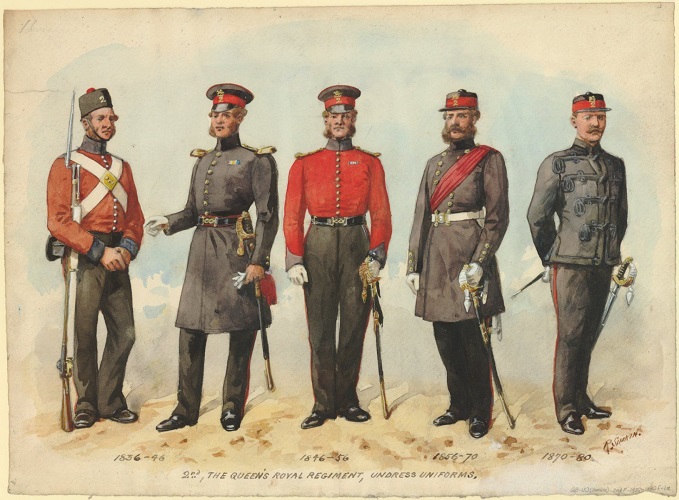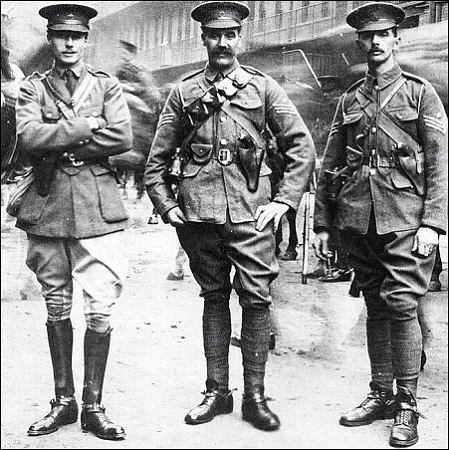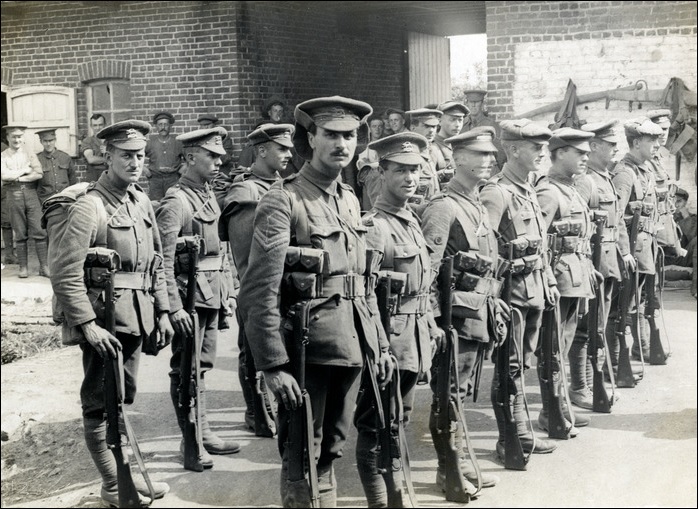● ● ●
When asked what he would do in the event of a European
war if the British Army made a landing on Germany’s North
Sea coast, Otto von Bismarck replied, “I would send for the
police.” And in 1914, with war in sight, Kaiser Wilhelm II
sneered that Britain had “a contemptible little army.”
It was true enough that compared with those of the other
major European powers, Britain’s army was extraordinarily
small. In 1914 the British Regular Army embodied only
270,000 active soldiers, half of them stationed overseas in
the colonies. The Army’s reserve amounted to 210,000 men,
just sufficient to bring units up to wartime strength and
replace the first losses. The Army was backed up by the
Territorial Force, 246,000 strong. This was a part-time
reserve organization, somewhat analogous to the US National
Guard; its members bore no obligation for overseas service.
Both the Regular Army and the Territorial Force were manned
by volunteers. Despite much argument and pressure from some
senior soldiers, Lord Roberts prominent among them,
successive British governments had balked at the imposition
of conscription.

The way it was: Soldiers
of the British Army, nineteenth century, as depicted in a
contemporary print.
But within the limits imposed by politics and tradition,
much progress had been made by military reformers since the
days of Rudyard Kipling’s “Barrack-Room Ballads,” his
imperishable pen portrait of what George Orwell called the
pre-machine-gun army. “From the body of Kipling’s early
work,” wrote Orwell:
[T]here does seem to emerge a vivid and not seriously
misleading picture of the old pre-machine-gun army—the
sweltering barracks in Gibraltar or Lucknow, the red coats,
the pipeclayed belts and the pillbox hats, the beer, the
fights, the floggings, hangings and crucifixions, the
bugle-calls, the smell of oats and horsepiss, the bellowing
sergeants with foot-long moustaches, the bloody skirmishes,
invariably mismanaged, the crowded troopships, the
cholera-stricken camps, the “native” concubines, the
ultimate death in the workhouse. It is a crude, vulgar
picture, in which a patriotic music-hall turn seems to have
got mixed up with one of Zola's gorier passages, but from it
future generations will be able to gather some idea of what
a long-term volunteer army was like.
By 1914, however, “Mr. Kipling’s Army” was no more. The
British Army that took the field in 1914 was small, but it
was a modern, well-trained, well-armed force. The unofficial
alliance with France—the Entente Cordiale—envisioned that in
the event of war British troops would go to the assistance
of the French Army. To make this possible the War Office
under Richard Burdon Haldane, Secretary of State for War,
embarked between 1906 and 1912 upon a far-reaching program
of military reform. The Regular Army in the United Kingdom
was reorganized as an expeditionary force of six infantry
divisions, one heavy cavalry division and two light cavalry
brigades with appropriate headquarters and support services,
to be mobilized and transported to France within three
weeks. The Haldane reforms thus introduced a permanent
divisional organization for the Regular Army. They also
created the Territorial Force by amalgamating the old
Militia and Volunteer organizations to form fourteen
infantry divisions and fourteen cavalry brigades for home
defense. New training manuals were published and the Army’s
support system was rationalized. Finally in 1909 an Imperial
General Staff was created. Its tasks included war planning,
supervision of military education and training, and military
coordination with the self-governing overseas Dominions.

Officer and NCOs of the
Household Cavalry, 1914. (Imperial War Museum)
The Haldane reforms were the culmination of a long and
fitful process that had dragged an often-reluctant Army into
the modern age. Most significant among earlier reforms was
the introduction of short service in 1872, replacing 21-year
regular enlistment for other ranks, which enabled a modest
reserve of trained men to be built up. After five or six
years with the Regular Army, short-service officers and
other ranks were released to civilian life with a liability
for annual training and recall to active duty in time of
war. Short service greatly expanded the pool of potential
recruits and raised the overall quality of the Army. The
British soldier of 1914 was better educated, better trained
and healthier than the “old sweats” of Kipling’s poetry. He
was also far better armed and equipped. Indeed, the six
British infantry divisions that took the field in August
1914 were probably superior to those of all the other
belligerents.
Many of the BEF’s officers and men were combat veterans
with considerable experience of colonial warfare. Infantry
training emphasized marksmanship and the British soldier was
unequaled in his ability to deliver rapid, accurate rifle
fire. But these advantages were to some extent offset by a
lack of experience at higher echelons of command. No British
general officer on active duty in 1914 had ever commanded
anything larger than a brigade. Thus while the BEF had a
modern command structure with an army headquarters over two
corps headquarters, each of the latter controlling three
infantry divisions, the men in command had only a
theoretical knowledge of their responsibilities. Staff
officers and technical experts were also in short supply, a
deficiency that was to become critical as the Army began to
expand.
In terms of armament the 1914 BEF was well provided for.
The standard rifle was the caliber .303 Short Magazine Lee
Enfield, the best weapon of its type in 1914. The SMLE was
backed up by the caliber .303 Maxim machine gun, of which
each division had 24. The division artillery was powerful,
with 54 18-pounder field guns backed up by 18 4.5-inch
howitzers and four heavy long-range 60-pounder guns. The
cavalry was also armed with the SMLE and the Maxim MG—which
proved far more effective in combat than the swords and
lances that troopers still carried.

BEF Infantry, 1914. They
wear the 1902 Pattern Service Dress, the 1908 webbing
equipment and are armed with the SMLE rifle. (Imperial War
Museum)
The British soldier’s appearance had also been
revolutionized, with the Army’s old colored uniforms
relegated to occasions of ceremony. They were replaced by
the 1902 Pattern Service Dress in a shade called khaki drab.
(Khaki is a Hindustani word meaning dusty and
it was in India that such uniforms first began to be worn.)
Leather belts and ammunition pouches had been replaced
in 1908 by
cloth webbing equipment of a type originally developed by
the American Mills Equipment Company. By the standard of the
day both uniform and webbing equipment were well designed
and practical.
But though much had changed, the roots of tradition
struck deep—and the regimental system, an institution unique
to the British Army, was the primary bastion of tradition.
In the infantry, the regiment as such was not a combat unit.
Infantry regiments of the line consisted of a regimental
depot, responsible for recruiting and training, and,
usually, two battalions, one in the UK and one serving
overseas. Line infantry regiments bore a territorial
identity, for instance the Royal Hampshire Regiment, and
recruited in that area. The cavalry and the Guards were
differently organized but for them too the regimental
mystique was a living force. The regiment was the embodiment
of the soldier's corporate identity, the focus of his
loyalty and pride. He wore his regiment’s distinctive
badges, perpetuated its peculiar traditions and remembered
its history, which often stretched back to the seventeenth
century. The senior infantry regiment, the Royal Scots,
notoriously proud of its ancient lineage, bore the nickname
“Pontius Pilate’s Bodyguard.” Traditional friendships and
rivalries between regiments were long remembered.
Certain regiments—the cavalry, the Guards, the Royal
Horse Artillery, the King’s Royal Rifle Corps—were socially
exclusive, and officers without a substantial private income
found it difficult to serve in them. Others, colloquially
known as “younger sons’ regiments,” were less pretentious.
But each one was unique. Even on khaki service dress the
soldiers of the Rifle Brigade continued to wear their
traditional black buttons. And for Highland regiments, the
khaki uniform was modified to permit the kilt to be worn.
But though it undoubtedly fostered esprit de corps, the
regimental system also bred a certain parochialism of
outlook incompatible with the demands of modern war. New and
novel organizations such as the Tank Corps tended to be
looked upon askance by officers and men of distinguished old
regiments whose colors bore battle honors from the Seven
Years War and Waterloo. Nor was the Regular Army
particularly enamored of the civilians in uniform who
increasingly filled the ranks as the war dragged on. A
good deal of snobbery greeted temporary officers of
undistinguished social background when they began to appear
in regimental messes after 1914. By then, however, there
were few members of the 1914 BEF still serving. All too many
of the Old Contemptibles—as they’d christened themselves
with typically self-depreciating humor—had found muddy
graves in the vicinity of an obscure Belgian town named
Ypres.
● ● ●